 |
 |
| Picture | Name | Desc | Price | Connectors | Dimensions |
|---|---|---|---|---|---|
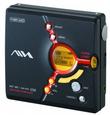 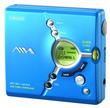 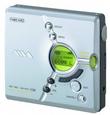 | Aiwa AM-NX9 | portable NetMD downloader Intro: 4/2003 | ``OPEN'' Availability: | In: USB. Out: headphones | |
Links:
Reviews: User Manual: AM-NX9 | |||||
| Picture | Name | Desc | Price | Connectors | Dimensions | |||||||||||
|---|---|---|---|---|---|---|---|---|---|---|---|---|---|---|---|---|
  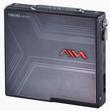 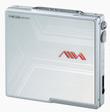 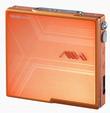 *See Notes   Stack: Sony MZ-N1 Aiwa AM-NX1 Sony MZ-E10  Photos: AVWatch | Aiwa AM-NX1 | portable NetMD downloader Intro: 3/2003 | Street: ¥ 30,000 Availability: | In: USB. Out: headphones | 80.3 x 74.2 x 17.9mm, 85g (w/batt) | |||||||||||
Features:
Notes: *Note hidden mic and line-in jacks in photo, apparently the rear-case from another unit was used for these publicity photos. Links: Included Accessories: Backlit LCD remote, Charging stand, AC adapter, NiMH cell, SonicStage V1.5 CD, AA cell case, carrying pouch, USB cable Specs: Headphone amp: 5mW+5mW into 16 ohms Reviews: User Manual: AM-NX1
| ||||||||||||||||
| Picture | Name | Desc | Price | Connectors | Dimensions | |||||||||||||||||||||
|---|---|---|---|---|---|---|---|---|---|---|---|---|---|---|---|---|---|---|---|---|---|---|---|---|---|---|
     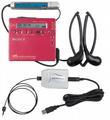 MZ-R900DPC   Aiwa AM-F90   R900/F90 comparison (1024x491) | Sony MZ-R900 Aiwa AM-F90 | portable MD recorder Intro: 9/2000 | Availability: | IN: optical/line, microphone. DC IN: 3V OUT: line/headphones | 78.2 x 17.1 x 72.0mm, 94g (120g w/batt) | |||||||||||||||||||||
Features: ATRAC IC: CXD2671-201GA. First MDLP mode portable recorder. Record-breaking battery life as of its release. A unique disc based settings ("Personal Disc Memory") feature remembers program play, treble & bass, repeat mode, playback speed (80-110%), and volume settings for up to 20 discs within the unit. 'Double' jog dial. First Sony portable with program play mode. Shock proof memory capacity depends on record mode-- LP4: 160s, LP2&mono: 80s, SP: 40s. Date stamp, digital REC level control, 8 step bass and treble settings, 1-99 minute melody timer. Selectable microphone sensitivity (HIGH/LOW). Aluminum body. Unit can be set to do END SEARCH automatically (no more accidentally erased recordings!); this settting is in NVRAM and remains even when batteries are removed. Available in silver, white, blue and red. 9 character backlit remote display. G-protection (anti-shock mechanism) present on US and Euro edition but not on Japanese model. Notes: End-Search can be permanently automated on the MZ-R900. Quoting from its user manual as follows: How to Set Rec-Posi: If you wish to avoid overwriting the currrent contents of an MD, do the following procedure. All new material will then be recorded from the end of the current contents.The Japanese section of the manual notes that these settings are retained even if the power is cut (oddly, the English section of the manual incorrectly translates this point). Overwrite recording is done by first positioning with Play-Pause at the overwrite point. User Comments on features: (noted by Leland McArthy)
User Comments on LP mode quality: (Ed Heckman) I've spent a couple of hours checking out the sound quality on my MZ-R900 and comparing it to my MZ-R50. To do this, I recorded "The throne room and end title" from the Star Wars suite digitally to a disc on the R50, then moved the disc to the R900 and recorded it again using standard stereo and LP2 modes. Then I listened to all 4 recordings through the R900 using my Sony NC10 earbuds. (The CD was played through the R900 with the R900 paused in record mode.) On a scale of 1-10 with the CD being placed at 10, this is how I would rank the sound quality of the various recordings:
User Comments on distortion: Tim Corcoran found distortion on two different MZ-R900 units. This problem does not exist on all units. Reviews:
Links:
Hacks:
Specs: Headphone amp: 5mW+5mW Service Manual: MZ-R900
| ||||||||||||||||||||||||||
| Picture | Name | Desc | Price | Connectors | Dimensions | |||||||||||||||
|---|---|---|---|---|---|---|---|---|---|---|---|---|---|---|---|---|---|---|---|---|
 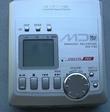  AM-F75 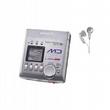 AM-F72  AM-C80 | Aiwa AM-F80 Aiwa AM-F75 Aiwa AM-F72 Aiwa AM-C80 | portable MD recorder Intro: 10/1999 | ¥37,800 Availability: | IN: mic/line/optical (3 in one connector). OUT: headphone/line. DC IN: 4.5V (AC adaptor), 1.5V (external AA cell) | 78.8 x 86.8 x 18.8mm, 163g w/batt. | |||||||||||||||
Features: Digital and analog synchro start, backlit LCD on body and remote, body keys are not illuminated (as they were on the AM-F70). Jog dial for volume control as well as track selection, editing and titling. Titling may be done while playing or recording, but not with the remote. Up to 100 titling characters per track. Remote displays 10 characters, main unit LCD shows 8 characters. Divide rehearsal mode. 25 track program play mode. Microphone sensitivity low/high selector. Double speed playback mode (mono and stereo). Japanese model (at least) comes with one-point stereo mic. Variants: The AM-C80 is apparently an AA dry-cell powered variant of the AM-F80 that comes with a car cassette adapter. The AM-F75 is a cost reduced version of the AM-F80 that drops the backlight and the remote's LCD. The AM-F72 is a further cost-reduced unit that drops the remote altogether. Links:
User Comments: Contrary to what I have read in some
comparisons, the number of titling characters for a track is not 50, but
100. • The 2X playback mode works in stereo too. What the unit does is
simply play every other sample, resulting in 2x the speed, but no pitch
shifting. To activate the mode, you hold the play button for 2sec (works
on the remote too). • The remote displays 10 characters, the main unit
only 8. • Nowhere in the manual is "line-out" mentioned and how to use
it (it's somehow combined with the headphone jack). • The included
headphones have a weird rubbery 'ear-coupling' arrangement. If you get
them in far enough, they have incredible bass response. Unfortunately I
think it's ear-shape dependent, and I don't seem to fit the mould. • The
jog-wheel doesn't click, so picking characters isn't as easy as it could
be. Also when adjusting the volume, the steps are a bit too large (only
20 steps in total, as opposed to 30 volume steps for Sony machines).
However because of the analogue-feel of the jog wheel, you can turn-up
or turn-down the volume as quickly as you want -- impossible with the
digital button-type volume controls in other units. • Response time from
'off' to 'play' is about 5 sec. Same as for MZ-R55. In fact the whole
unit feels a lot like the MZ-R55, except that it has heaps more
features, and 3-4 times the battery life. • Overall, this may not be the
smallest unit in the world, the MZ-R90 has a few milimeters advantage,
but in terms of usability and features, this one wins hands down.
Reviews: User Manual: AM-F80
| ||||||||||||||||||||
| Picture | Name | Desc | Price | Connectors | Dimensions | |||||||||||||||
|---|---|---|---|---|---|---|---|---|---|---|---|---|---|---|---|---|---|---|---|---|
  | Aiwa AM-F65 Aiwa AM-F70 | Portable MD recorder Intro: 12/1998 | MSRP ¥42,000 Availability: | IN: line/optical, mic. OUT: line/headphone | 77.6 x 19.3 x 97mm, 187g (w/rechargeable cell) | |||||||||||||||
Features:
Variants: The Aiwa AM-F65 has been released in Europe, it is nearly identical to the AM-F70 but has no backlight on the main unit's LCD panel, has no LCD panel on remote, and comes without dry cell case (for AAx3). Tips:
Links:
Specs: Freq. resp: 20-20kHz +/-1dB @ 10KOhm. Headphone amp: 10mw + 10mw Reviews: User Manual: AM-F65 Electronic Shopping Mall
| ||||||||||||||||||||
| Picture | Name | Desc | Price | Connectors | Dimensions | |||||||||||||||
|---|---|---|---|---|---|---|---|---|---|---|---|---|---|---|---|---|---|---|---|---|
 AM-F5  AM-F7 | Aiwa AM-F5 Aiwa AM-F7 | Portable MD recorder Intro: 12/1997 | MSRP ¥45,000 (initial production 8000 units/mo) Availability: | in: mic, line, digital. out: line, headphones. DC in: 4.5v | 97x21.6x77.6mm, 189g (main unit only), 216g w/batt | |||||||||||||||
Features:
Variants: AM-F7 model is nearly identical to AM-F5. It adds a backlit remote (plus firmware changes to drive it) and a few bug fixes. Links: Nic Boyde's page for the unit. Aiwa Germany's page for the unit. Aiwa's English announcement for their AM-F7 MD portable Doug Rice shows how he made a Remote Control Timer for an Aiwa AM-F5. Reviews: User Manual: AM-F5
| ||||||||||||||||||||
| Picture | Name | Desc | Price | Connectors | Dimensions |
|---|---|---|---|---|---|
 | Aiwa AM-F3 | portable recorder Intro: 1/1996 (?) | msrp: Y58,000 Availability: | in: optical/line, mic. out: line, hdphn/remote. | 109.3 x 81.8 x 26.5mm 290g w/rechargeable attached |
Features: Stereo/mono recording, 1bit d/a a/d. Backlit panel
and buttons (buttons backlit on AC adapter only), Empty, Mid, Full
battery level indicator. Optical, Line, Mic input done with one jack and
a line/mic switch. Line/Headphone output similarly done with 1 jack and
a switch. Six mode "DSP" (parametric equalizer with flat, rock, pop,
jazz, bassboost, and `live' settings). Display has 4 modes: 1) track
no./elapsed track time, 2) track no./remaining track time, 3) remaining
no. of tracks/remaining disc time. 4) date and time stamp info (though
in this mode time does not increment). Display repeatedly scrolls
current track name. Four track marking modes: 1) copy marks present in
digital input signal, 2) make a mark every 5 minutes (appropriate for
meetings and lectures), 3) manual mode (push button to mark), 4) make a
mark after 3 seconds of silence. Double speed playback. Auto start/pause
mode (sound activated) records only while sound is present on mic inputs
(may be set to high or low sensitivity and is also affected by mic input
gain setting). Character input for titling, which can be done from the
main unit or from the remote, in which case the volume knob is used(!)
to select the characters. Up to 50 letters, numbers, symbols, or kana
may be entered per track. Writes recording date and time on each track.
Manual/Auto recording level adjust (level can be manually adjusted and
switched between auto and manual modes during recording). Play modes:
repeat 1, repeat all, random play (operates properly, will not repeat
tracks), program play, index search function (entire disc's song names
are scrolled in display, pressing 'enter' as one scrolls past causes
song to play). Settable preferences: enable/disable ear guard function,
enable/disable resume function, enable/disable LCD backlight (when
disabled, backlight can be turned on for 3 seconds with DISP button),
set LCD contrast. Recharge time: 2 hr=90%, 5 hr=Full. Rechargeable cell:
LIP-12. Unique "clip on" attachment of LIP-12 rechargeable or 2 AA
drycell case to side of unit. Playback: 2 AA only: 4 hr, Rechargeable
only: 6 hr. Record: 2 AA only: 1 hr, Rechargeable only: 3.5 hr
Mis-features: Cannot simultaneously charge battery and operate on AC adapter. In pause mode the fast foward/rewind function is unavailable, only track skip. Unit only records in append mode, cannot overwrite existing tracks. Links: Bala Swaminathan's review of the Aiwa AM-F3, Aiwa's Japanese page for the unit. Reviews: User Manual: AM-F3 | |||||
| Picture | Name | Desc | Price | Connectors | Dimensions |
|---|---|---|---|---|---|
 | Aiwa AM-F1 | portable recorder Intro: 12/1993 (? est.) | msrp: Availability: | in: optical/line, mic. out: optical/line/hdphn/remote. | 85x105x30 |
Features: ATRAC 2. Double speed playback, mono recording, back lit display, illuminated buttons, many index modes. Play modes: repeat 1, all, shuffle, random. Volume control on unit is digital, on remote is dial. "DSL" bass boost (3 levels). Editing: combine, divide, renumber, erase, erase all. Editing example: 1) Position unit to required point or track. 2) Select "edit", then toggle with "edit" to select function. To move use |<< or >>| to change the track number, then enter >>|. Text entry uses volume + and -. Edit positioning to within 1 second acuracy. -20dB Mic atten switch. Playback time: Li 2.5, ext. AA 2.5, both 6.5 hours. Recording: Li 2, ext. AA 2, both 4.5 hours. Dim: 1.5" x 4.5" x 5.5" -Ian Ogilvy Reviews: | |||||
| Picture | Name | Desc | Price | Connectors | Dimensions | |||||||
|---|---|---|---|---|---|---|---|---|---|---|---|---|
    | Aiwa AMD-100 | portable recorder Intro: 12/1992 (?) | msrp: $600 street: $250? Availability: | In: optical, line, mic (1.38mv min:0.55mv). Out: optical, line, hdphn (5mwx2 max, load 16 ohms) | 4 1/2" x 1 5/8" x 5 1/2" 1.1lbs | |||||||
Features:
Reviews:
| ||||||||||||